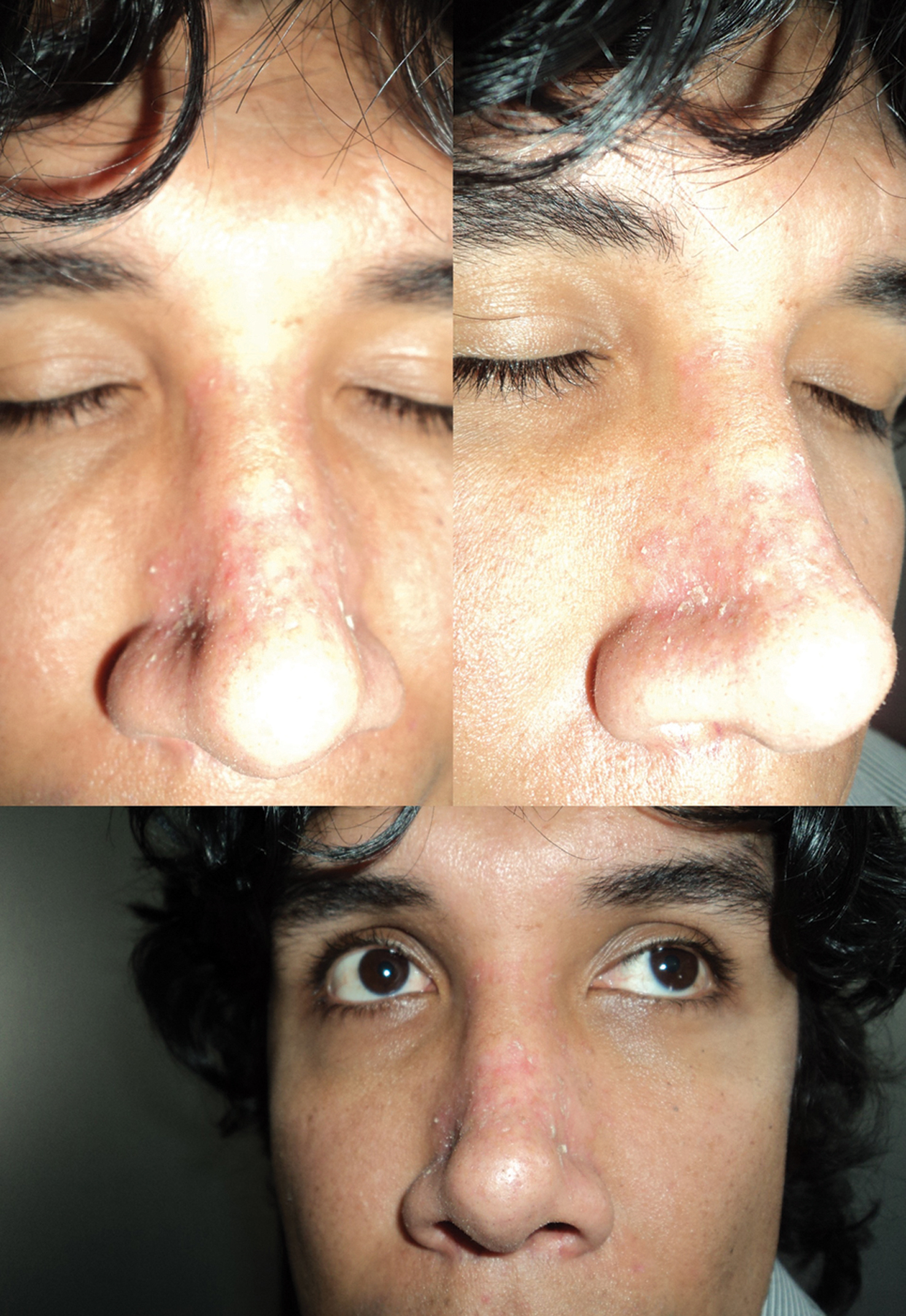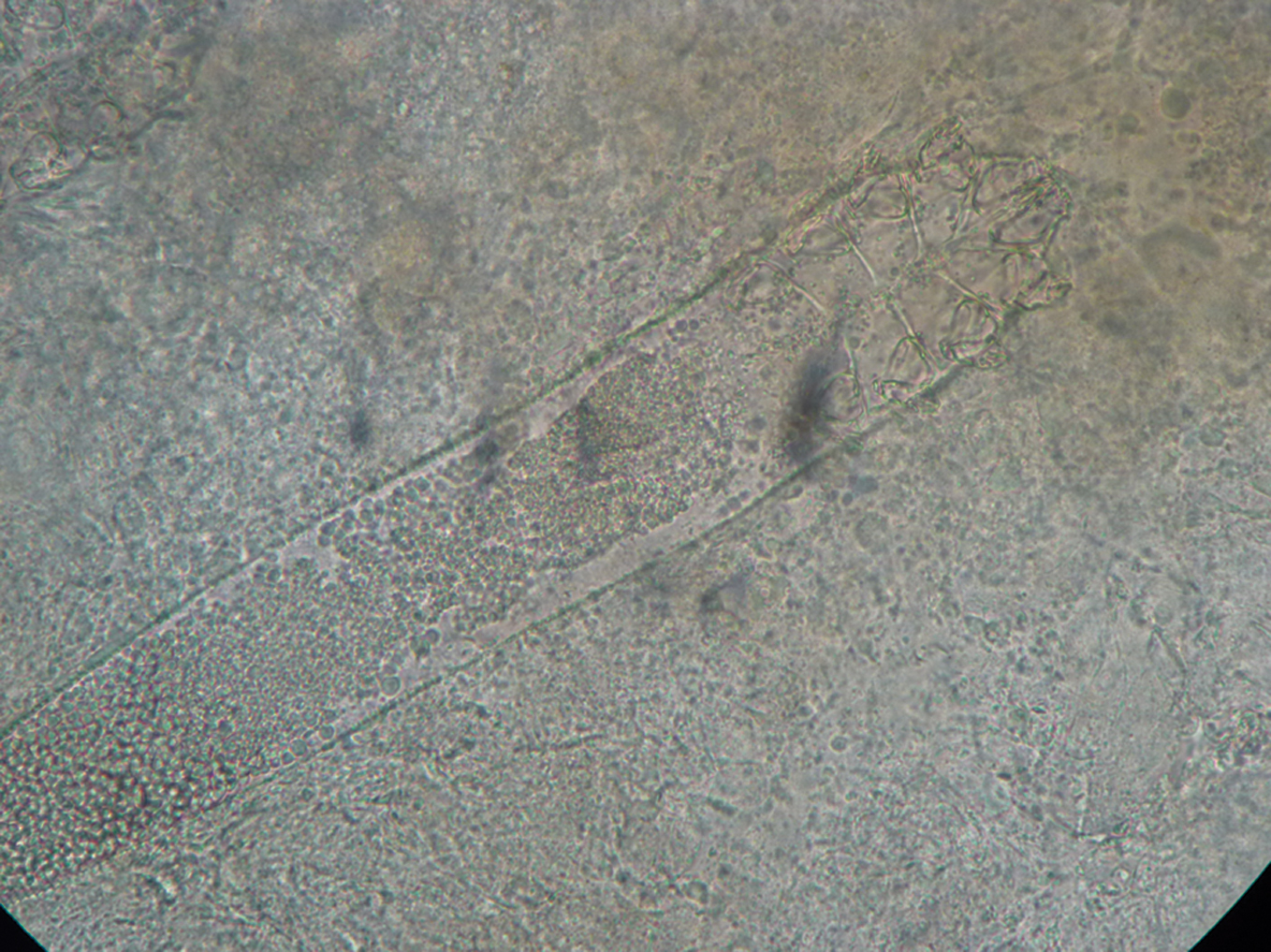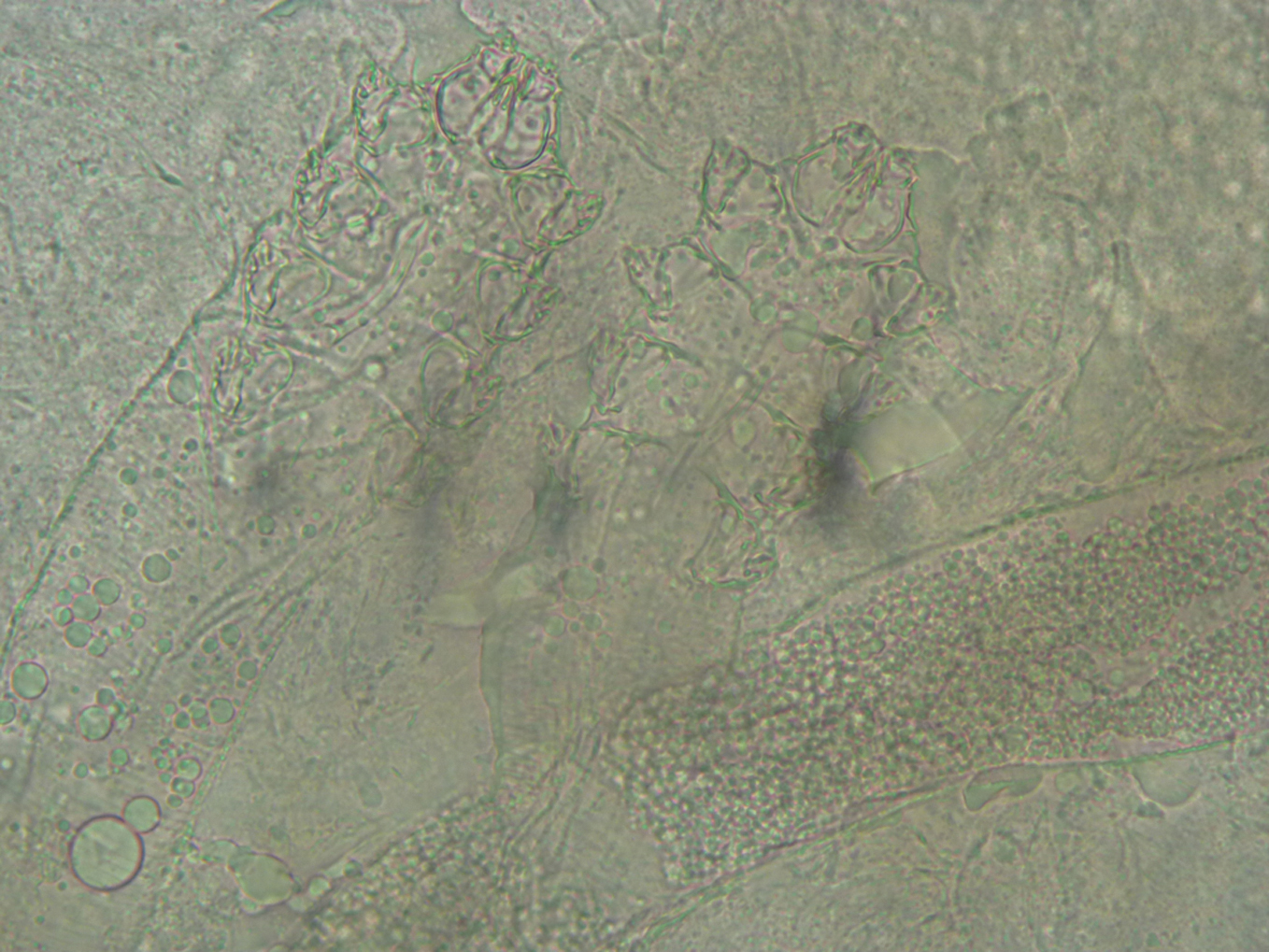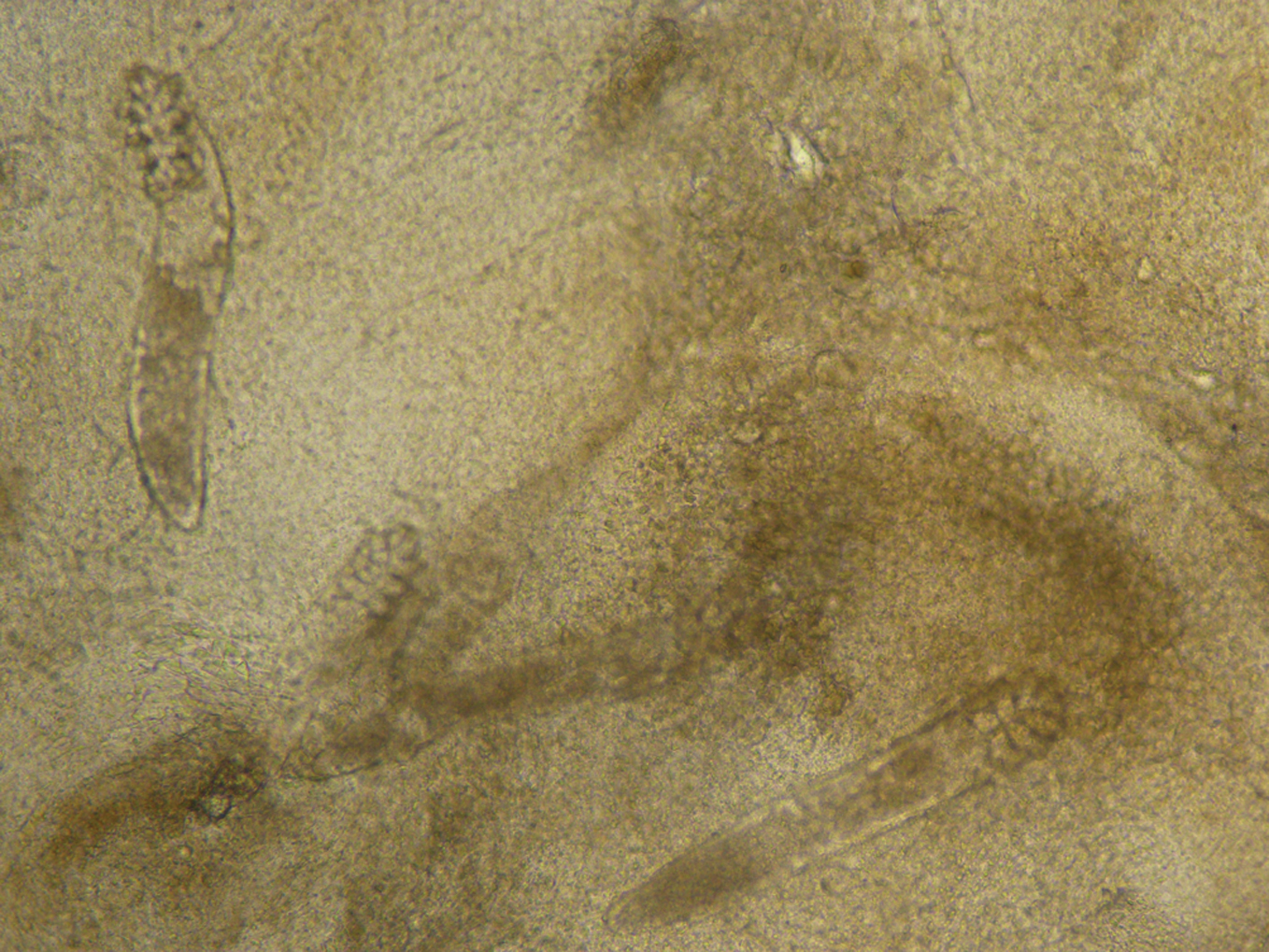Our Dermatol Online. 2013; 4(1): 98-100
DOI:. 10.7241/ourd.20131.22
Date of submission: 28.08.2012 / acceptance: 03.10.2012
Conflicts of interest: None
SEBORRHEIC DERMATITIS BY DEMODEX FOLLICULORUM
DERMATITIS SEBORREICA POR DEMODEX FOLLICULORUM
Max Carlos Ramírez Soto
Clinical Pathology Service, Santa Teresa Clinic of Abancay, Apurímac, Peru
Corresponding author: Dr. Max Carlos Ramírez Soto e-mail: maxcrs22@gmail.com
How to cite an article: Ramírez Soto MC. Seborrheic dermatitis by Demodex folliculorum. Our Dermatol Online. 2013; 4(1): 98-100.
A Male patient, 28 years old, presents bilateral dermatitis with rosacea-rash on the nasal dorsum, accompanied by intense itching, scaling and burning for about four months. He did not refer an important personal medical history (Fig. 1-3). According to the topography and morphology, seborrheic dermatitis was diagnosed and then we procedure with the direct microscopic examination. We took a sample of scaly skin of the injured area for soaking with potassium hydroxide solution (KOH) to 10%. With this procedure, we observed adult specimens of Demodex folliculorum and revealed a density of 5 Demodex per field (Fig. 4-7). Photographs were taken with the consent of the patient. The publication of the photographs was authorized by the patient. The Demodex folliculorum is a mite that is between 0.3 to 0.4 mm long [1]. It is the most common ectoparasites on humans. Their food source is sebum, concentrating mainly on the cheeks, cheekbones, forehead, nose and eyelids. The density in normal skin is less than five per cm2, but the presence of 5 or more mites in 1cm2 has clear implications pathological [2.3]. Described various clinical forms of Demodex infestation in humans, called Demodicosis such as seborrheic dermatitis, pityriasis folliculorum, rosacea demodicosis like [4]. Seborrheic dermatitis is a chronic and inflammatory dermatosis with unknown etiology and many associated factors. The Demodex folliculorum plays an important role in the etiology of this disease, since the number of mites is significantly higher in patients with seborrheic dermatitis [5]. The importance of suspecting Demodex folliculorum infestation in cases of seborrheic dermatitis and the importance of direct microscopic examination with KOH, allows the observation and quantification of Demodex folliculorum.
Paciente varón de 28 años de edad, acude por una dermatosis bilateral con erupción de tipo rosácea en el dorso nasal, acompañado de intenso prurito, descamación y sensación de quemazón de cuatro meses de evolución. No refirió antecedentes patológicos personales de importancia (Fig. 1-3). De acuerdo a la topografía y morfología, se diagnosticó dermatitis seborreica y se le indicó el examen microscópico directo. Se tomó una muestra de escamas de la zona lesionada para su maceración con solución de hidróxido de potasio (KOH) al 10%. Con este procedimiento se observaron ejemplares adultos de Demodex folliculorum y se reveló una densidad de 5 Demodex por campo (Fig. 4-7). Se tomaron fotografías previo consentimiento del paciente. La publicación de las fotografías fue autorizada por el paciente. El Demodex folliculorum es un ácaro que mide entre 0,3 a 0,4 mm de largo [1]. Es el ectoparásito más común en el ser humano. Su fuente de alimento es el sebo, concentrándose principalmente en las mejillas, pómulos, frente, nariz y párpados. La densidad en piel normal es menor a cinco por cm2, pero la presencia de 5 o más ácaros en 1cm2 tiene implicancias patológicas claras [2,3]. Se han descrito diversas formas clínicas de infestación por Demodex en humanos, denominadas Demodicosis como la dermatitis seborreica, pitiriasis folliculorum, demodicosis rosácea like [4]. La dermatitis seborreica es una dermatosis inflamatoria y crónica, con una etiología desconocida y muchos factores asociados. El Demodex folliculorum juega un rol importante en la etiología de esta enfermedad, ya que el número de ácaros es significativamente superior en los pacientes con dermatitis seborreica [5]. Se destaca la importancia de sospechar la infestación por Demodex folliculorum en los casos de dermatitis seborreica y la importancia del examen microscópico directo con KOH, permite la observación y cuantificación de Demodex folliculorum.
 |
Figure 1-3. Male patient, 28 years old, presents bilateral dermatitis with rosacea-rash on the nasal dorsum
 Figure 4. Photomicrography. Demodex folliculorum adult. Side view
|
 Figure 5. Photomicrograph. Demodex folliculorum adult, ventral view showing the gnathosoma or cephalothorax, podosoma with four pairs of legs and opisthosoma or abdomen striatum
|
 Figure 6. Typical clustering of Demodex folliculorum. Ventral view
|
 Figure 7. Direct microscopic examination with KOH: 5 emodex per field (10X)
|
REFERENCES
1. Lacey N, Kavanagh K, Tseng SC: Under the lash: Demodex mites in human diseases. Biochem (Lond). 2009;31:2-6.
2. Forton F, Seys B, Marchall JL, Song AM: Demodex folliculorum and tropical treatment: acaricidal action evaluated be standarized skid surface biopsy. Br J Dermatol. 1998;138:461-6.
3. Askin Ü, Se?kin D: Comparison of the two techniques for measurement of the density of Demodex folliculorum: standarized skin surface biopsy and direct microscopic examination. Br J Dermatol. 2010;162:1124-6.
4. Hsu CK, Hsu MM, Lee JY: Demodicosis: a clinicopathological study. J Am Acad Dermatol. 2009;60:453-62.
5. Karincaoglu Y, Tepe B, Kalayci B, Atambay M, Seyhan M: Is Demodex folliculorum an aetiologic factor in seborrhoeic dermatitis? Clin Exp Dermatol. 2009;34:e516-20.
Comments are closed.